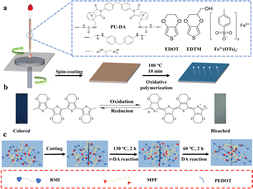Since the cracks or scratches that occur during use can degrade the performances and lifetime of organic film electronic devices, the development of self-healing materials holds great potential for durable and sustainable electrochromic devices. However, the simultaneous self-healing of the structures and functions of electrochromic materials still faces enormous challenges. In this study, a strategy to synthesize intrinsically self-healing electrochromic polymer composite films was introduced by integrating electrochromic poly(3,4-ethylenedioxythiophene) (PEDOT) units with thermally self-healable polyurethane (PU-DA) containing reversible Diels–Alder groups. To adjust the self-healing and electrochromic behavior, the copolymerization of 3,4-ethylenedioxythiophene (EDOT) and its hydroxymethyl derivative (EDTM) was also carried out. In terms of a good balance of morphology, self-healing and electrochromic parameters, the prepared intrinsically conductive P(EDOT-co-EDTM)/PU-DA copolymer film has excellent electrochromic properties including a visible light contrast ratio of 47.24%, a fast response time of 0.8 s, and a coloration efficiency of 324.9 cm2 C−1. The visible light contrast can be maintained above 93% after 100 cycles. Moreover, the film after breaking up can be intrinsically self-healed through thermal stimulation (no more than 130 °C), and maintains the optical contrast at 95% of the original state.

